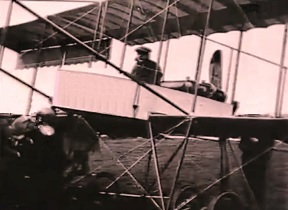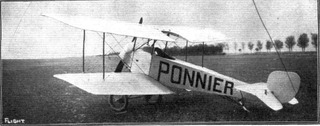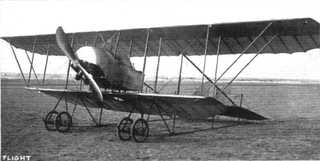Related Research Articles

The Avro Type E, Type 500, and Type 502 made up a family of early British military aircraft, regarded by Alliott Verdon Roe as his firm's first truly successful design. It was a forerunner of the Avro 504, one of the outstanding aircraft of the First World War.

The Bristol Gordon England biplanes were a series of early British military biplane aircraft designed by Eric Gordon England for the Bristol Aeroplane Company that first flew in 1912. Designed for easy ground transport, the aircraft could be quickly disassembled.

The Handley Page Type E was a two-seat, single-engined monoplane intended as a demonstrator. Though only one was built, it flew successfully from 1912 to 1914, carrying several hundred passengers and flying several thousand miles.

The ASL Viking was a single-engined two seater biplane aircraft designed and built by Horatio Barber's Aeronautical Syndicate Ltd. at Hendon. It was first flown in January 1912.
The Gabardini biplane was an Italian single seat biplane, designed and built near the beginning of World War I. It was an advanced trainer and could be fitted with engines of output between about 40 to 80 kW.

The Spijker, Spyker V.1 or Spyker-Trompenburg V.1, was a single seat biplane fighter built in the Netherlands during World War I. It was underpowered and did not go into production.

The Koolhoven Heidevogel was one of the first Dutch aircraft, an improvement of the popular Farman type.

The Kondor D 6 was a prototype German biplane fighter aircraft flown in 1918. In the interests of better upward vision for the pilot, its upper wing was in two halves, separated over the central fuselage. Its development was soon abandoned.

The Ponnier L.1 was an early French biplane single seat scout, built just before World War I. It did not reach production.

The Blériot XXI was an early French aircraft built by Blériot Aéronautique.
The Caudron C.21 was a French twin engine biplane built just after World War I, able to carry three passengers in an open cockpit.

The Caudron Type L was a two-seat French pusher configuration amphibious biplane, flown around 1913 and intended for naval use.
The Caudron Type B was a 1911 development of the earliest Caudron type, the Caudron Type A, with a nacelle style fuselage and more powerful engine. Initially an equal span biplane, it was modified into a sesquiplane.

The Caudron Type F was a French single seat biplane produced just before World War I. A dozen were bought by China and at least two other examples, with different engines, competed in 1913, coming first and second in the biplane category of the cross-country race at Reims. Flown by Pierre Chanteloup, one was the first biplane to loop-the-loop.
The Itoh Emi 2 was a revised and cleaned up development of his first aircraft, the Itoh Emi 1.
The Itoh Emi 3 was the first Japanese civil passenger carrying seaplane, flown in 1917 and used for commercial demonstrations and passenger flights.
The Itoh Emi 13 was a two seat Japanese trainer, designed for the Itoh flying school and introduced in two versions in 1920 and 1921.
The Itoh Emi 14 was a Japanese biplane designed in 1920 for a long distance competitive flight from Tokyo to Osaka and back, which it won. It was also successful at a contest later that summer, before suffering terminal structural failure during aerobatics a few weeks later.
The Itoh Emi 16 Fuji-go (Fuji), built in 1920, was intended as a cheap and simple general purpose civil biplane but gained publicity with exhibition flights and successful speed and altitude contests against higher-powered fighter aircraft.
The Itoh Emi 30 was a small, single-engined, sports biplane built in Japan in 1922. Though it attracted attention by being the smallest Japanese aircraft of its time, the sole example was mostly used as an aerobatics trainer.